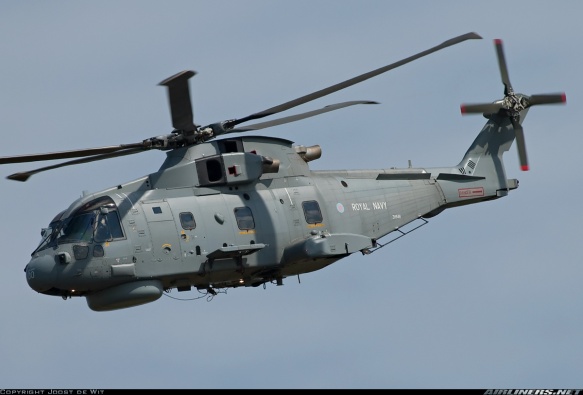As early as the late 1970s the British Royal Navy began a search to replace its technologically aging Sea King ASW helicopters. In response GKN Westland initiated the WG 34 project. Simultaneously, the Italian Navy considered replacing its own Sea Kings. Consequently the two governments agreed to develop a new ASW helicopter jointly. The agreement led to the establishment of European Helicopter Industries (EHI) in June 1980 (Agusta-Westland on February 12, 2001) and a joint funding arrangement on January 25, 1984. Westland and Agusta spent almost eight years in an assiduous design program before the first EH 101 prototype took to the air on October 9, 1987.
The medium lift multirole helicopter, capable of carrying up to fifty-five survivors in the SAR variant, depended on three General Electric CT7-6 2,000-horsepower turbines, mounted atop the fuselage, to turn the advanced 61-foot, five-bladed main and four-bladed tailrotors, fabricated with a carbon-glass skin and a nomex-foam honeycomb core. The EH 101 cruised comfortably at 150 knots and exhibited a range of 460 nautical miles without the available auxiliary fuel tank; designers fitted the military variants with a hover inflight refueling (HIFR) system. The external hook safely lifted loads up to 12,000 pounds. Sponsons along the lower aluminum-lithium fuselage housed a retractable tricycle landing gear. EHI’s program called for nine preproduction aircraft, two utilized for civil certification.
The cockpit contained dual controls and the latest in advanced instrumentation. Six full-color MFDs linked to an advanced flight management system, including an Automatic Heading-Reference System, AHRS, weather radar, and integrated avionics suite provided necessary information and control for certification as a single-pilot IFR helicopter. Deicing equipment on engine inlets and rotor blades added an all-weather component to the helicopter’s capabilities.
The long development cycle resulted from the myriad of requirements stipulated by the two militaries. The RN required a multipurpose ASW model, the RAF an SAR/utility aircraft, while the Italian Navy demanded three variants, an ASW version, a surveillance radar picket aircraft, and a naval utility transport with both folding blades and tail section, along with a rear-loading cargo ramp. With folding blades and tail, the EH 101 could operate from small frigates and fit into the same underdeck hangars as the Sea King. In March 1996 the first of forty-four EH 101 Merlin HMA1s ordered by the Royal Navy took flight. On May 27, 1997, the first of these ASW helicopters arrived at an RN squadron. Shortly afterward, the RAF received the first of twenty HC3 utility helicopters. Canada ordered fifteen EH 101 Cormorant SAR helicopters to replace the Canadian Armed Forces’ fleet of Boeing CH-113s. Other international orders included the following: Denmark, fourteen search and rescue and troop transport variants; Portugal, twelve SAR and fishery protection aircraft; and Japan, fourteen for utility transport and mine countermeasures.
Shortly after the Cormorant went into service with the Canadian military in 2002 it performed its first rescues. On July 28 a crewman aboard the container ship Cynthia Melody received a serious head injury, and the ship’s captain called for immediate medical assistance. A Cormorant, piloted by Captain Jennifer Weissenborn, flew through “poor weather” to rendezvous with the ship about 115 miles north of Vancouver Island. Hovering over the deck, the crew lowered two search and rescue technicians onto the ship to stabilize the patient and then hoisted him aboard the helicopter by a Stokes litter. The Cormorant crew then delivered the injured man to a hospital in Comox, Nova Scotia. The second rescue occurred two days later, when a Cormorant landed in inhospitable terrain to rescue a father and his two sons after they were forced to put down their chartered plane on account of bad weather.
The commercial version of the EH 101 flew in 1997 and was offered in two variants, one with a rear-loading cargo ramp and the Heliliner version, with plush seating for thirty passengers. The cabin featured full standing room, a wide central aisle, overhead storage and a large baggage compartment, as well as a powerful cooling/heating system for passenger comfort. In the medical evacuation role the cabin held sixteen stretchers, along with medical equipment and attendants.
